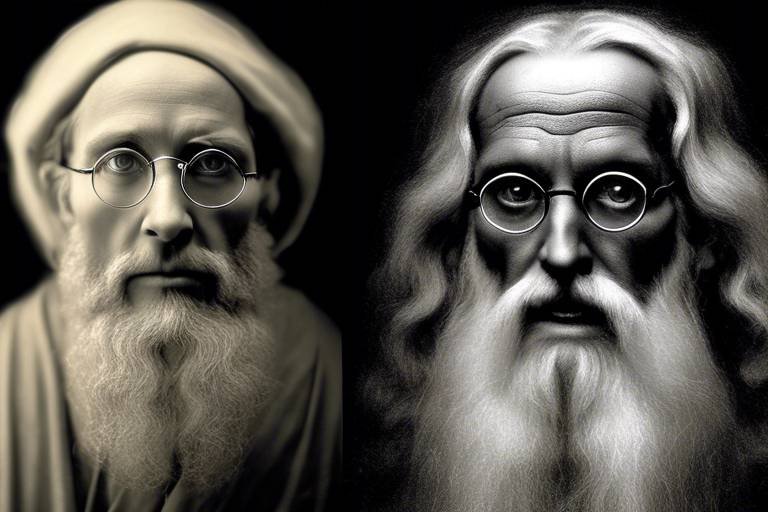The Philosophy of Dark Matter and Dark Energy
Have you ever looked up at the night sky and wondered what lies beyond the twinkling stars? It’s a question that has puzzled humanity for centuries, and the concepts of dark matter and dark energy are at the forefront of this cosmic inquiry. These two mysterious components make up about 95% of the universe, yet they remain largely elusive, challenging our very understanding of reality. In this article, we will explore the philosophical implications of these enigmatic phenomena and how they reshape our perception of existence itself.
Dark matter is often described as an invisible substance that exerts gravitational forces, influencing the motion of galaxies and clusters in ways that cannot be explained by visible matter alone. It’s as if the universe is playing a cosmic game of hide and seek, where what we can see is just the tip of the iceberg. This raises profound questions: If dark matter is so prevalent, what does that say about the nature of existence? Are we merely perceiving a fraction of reality, or is our entire understanding of the universe fundamentally flawed?
On the other hand, dark energy is an even more perplexing concept. Responsible for the accelerated expansion of the universe, it suggests that the cosmos is not only expanding but doing so at an increasing rate. This revelation leads us to ponder the future of the universe—will it continue to expand indefinitely, or is there a point at which it will collapse? The implications of dark energy extend beyond mere astrophysics; they touch on existential questions about time, space, and the ultimate fate of everything we know.
As we delve deeper into the realms of dark matter and dark energy, we cannot ignore the historical context that has shaped our understanding. From early theories that laid the groundwork for these concepts to modern discoveries that have revolutionized our perspective, the journey is as fascinating as the phenomena themselves. The evolution of these ideas invites us to consider not just what we know, but how we know it, and what it means for our grasp of reality.
In the end, the philosophy of dark matter and dark energy invites us to embrace uncertainty. It challenges us to confront the limitations of our perception and the methodologies we use to explore the universe. As we stand on the precipice of understanding, we must ask ourselves: Are we ready to accept that the universe may be far more complex than we can imagine? Or will we cling to our existing beliefs, even in the face of overwhelming evidence to the contrary? The answers may lie in the very fabric of the cosmos, waiting to be unraveled by curious minds.
- What is dark matter? Dark matter is a form of matter that does not emit light or energy, making it invisible and detectable only through its gravitational effects on visible matter.
- What role does dark energy play in the universe? Dark energy is a mysterious force that is driving the accelerated expansion of the universe.
- How do scientists study dark matter and dark energy? Scientists use various observational techniques and theoretical models to infer the presence and effects of dark matter and dark energy, despite their invisibility.
- What are the philosophical implications of these concepts? The existence of dark matter and dark energy challenges our understanding of reality, existence, and the limits of human perception.

Understanding Dark Matter
Dark matter is one of the universe's greatest mysteries, an invisible substance that comprises about 27% of the cosmos. This enigmatic material does not emit, absorb, or reflect light, making it undetectable by conventional means. So, how do we know it exists? The answer lies in its gravitational effects on visible matter, radiation, and the large-scale structure of the universe. Imagine a cosmic dance where the stars and galaxies swirl around a massive, unseen partner—dark matter. Its presence is inferred from the way galaxies rotate and the way light bends around massive objects, a phenomenon known as gravitational lensing.
Philosophically, dark matter challenges our understanding of existence itself. If something can exist without being seen or measured directly, what does that say about the nature of reality? It forces us to confront the limitations of our perception and the tools we use to explore the universe. Are we only able to comprehend what we can see, or is there a vast realm of existence beyond our sensory capabilities? This question is not merely academic; it touches on the very fabric of how we understand our place in the universe.
To further illustrate the significance of dark matter, consider the following properties:
- Massive Influence: Dark matter's gravitational pull affects the motion of galaxies and galaxy clusters.
- Non-Interacting: Unlike ordinary matter, dark matter does not interact with electromagnetic forces, meaning it doesn't emit light.
- Cosmic Structure Formation: It plays a crucial role in the formation of galaxies, acting as a scaffold around which visible matter clusters.
Understanding dark matter isn't just about astrophysics; it intertwines with existential questions. If our universe is predominantly made up of something we cannot see, how does that affect our understanding of reality? This notion parallels philosophical arguments about the nature of existence and perception. It nudges us to reconsider the boundaries of what we deem 'real.' Are we, as conscious beings, capable of grasping the full extent of the universe, or are we forever limited by our own senses?
Moreover, the quest to uncover the properties of dark matter has sparked a myriad of scientific endeavors. Physicists are tirelessly working to detect dark matter particles through experiments designed to reveal their elusive nature. The challenge is akin to trying to catch smoke with your bare hands—frustrating yet fascinating. This ongoing pursuit not only enhances our scientific knowledge but also deepens our philosophical inquiries into the very essence of existence.

The Nature of Dark Energy
Dark energy is one of the most mysterious components of our universe, making up about 68% of the cosmos. It acts as a driving force behind the universe's accelerating expansion, but what exactly is it? Imagine standing on the edge of a vast ocean, with waves crashing relentlessly against the shore. The ocean represents the universe, while the waves symbolize the expansion fueled by dark energy. Just as the ocean's depths are largely unexplored, so too is our understanding of dark energy, which challenges our fundamental notions of existence and reality.
To grasp the essence of dark energy, we must first consider its characteristics. Unlike ordinary matter, which interacts with electromagnetic forces and can be observed through light, dark energy is elusive and invisible. It doesn't clump together like galaxies or stars; instead, it appears to be uniformly distributed throughout space. This uniformity leads to intriguing philosophical questions: If dark energy is everywhere, does that imply a hidden structure to the universe? Or does it suggest a fundamental change in how we perceive space and time?
One of the most profound implications of dark energy is its potential impact on the fate of the universe. As the universe continues to expand, will it eventually reach a point of no return, spiraling into a state of eternal expansion? This scenario, known as the Big Freeze, raises questions about the ultimate destiny of all matter and energy. Will galaxies drift apart until they are mere memories, leaving behind a cold, dark universe? The thought can be chilling, yet it also invites us to ponder the nature of existence itself. Are we merely fleeting observers in a vast, indifferent cosmos?
Philosophically, dark energy invites us to reconsider our understanding of time and space. Traditional views often depict time as linear and space as a static backdrop for events. However, the accelerating expansion of the universe suggests a dynamic interplay between the two. If space is stretching and time is accelerating, what does that mean for our perception of reality? Are we witnessing the end of time as we know it, or is this merely the beginning of a new cosmic chapter?
In summary, dark energy is not just a scientific concept; it is a catalyst for deep philosophical inquiry. It challenges our assumptions about the universe and our place within it. As we continue to explore this enigmatic force, we are prompted to ask fundamental questions about existence, reality, and the nature of the cosmos itself. The more we learn, the more we realize how little we truly understand, echoing the sentiment that the universe is not just a collection of stars and galaxies, but a profound mystery waiting to be unraveled.
- What is dark energy? Dark energy is a mysterious force that makes up about 68% of the universe and is responsible for its accelerating expansion.
- How does dark energy affect the universe? Dark energy drives the acceleration of the universe's expansion, influencing its ultimate fate.
- Can we observe dark energy directly? No, dark energy cannot be observed directly; its effects are inferred from astronomical observations.
- What are the potential outcomes of dark energy's influence? The most discussed outcomes include the Big Freeze, where the universe continues expanding indefinitely, leading to a cold and dark cosmos.

Historical Context
The journey to uncover the mysteries of dark matter and dark energy has been nothing short of a cosmic odyssey. It all began in the early 20th century when astronomers first started to notice peculiar discrepancies in the motion of galaxies. These observations led to the realization that the universe is not merely composed of the visible matter we see around us, but also includes enigmatic substances that elude direct detection. The term "dark matter" was coined in the 1930s by Swiss astronomer Fritz Zwicky, who noticed that the mass of galaxy clusters was far greater than what could be accounted for by visible stars and gas alone. This was the first hint that something unseen was influencing the motion of celestial bodies.
Fast forward to the late 20th century, and the concept of dark energy emerged as scientists grappled with the unexpected discovery that the universe's expansion is not slowing down as previously thought, but rather accelerating. This revelation was made possible by observations of distant supernovae in the late 1990s, leading to the conclusion that a mysterious force—now termed dark energy—was at play. The implications of these discoveries are profound, as they challenge our fundamental understanding of the universe and our place within it.
To better appreciate the historical context, let's look at some key milestones:
| Year | Milestone |
|---|---|
| 1933 | Fritz Zwicky proposes the existence of dark matter based on galaxy cluster dynamics. |
| 1970s | Vera Rubin's work on spiral galaxies provides strong evidence for dark matter's presence. |
| 1998 | Discovery of the universe's accelerating expansion, leading to the concept of dark energy. |
| 2003 | NASA's Wilkinson Microwave Anisotropy Probe (WMAP) provides detailed measurements of cosmic microwave background radiation, supporting dark energy theories. |
These milestones not only highlight the scientific advancements but also reflect the evolving philosophical inquiries about existence and reality. As scientists pushed the boundaries of knowledge, they unearthed questions that transcended empirical observation. What does it mean for something to exist if it cannot be seen or measured? How do we reconcile the vastness of the universe with our limited perception? These inquiries are at the heart of the philosophical implications of dark matter and dark energy, inviting us to rethink the very nature of reality.

Early Theories
In the vast expanse of the universe, the quest to understand its fundamental components has been a long and winding journey. The early theories surrounding the cosmos laid the groundwork for our current understanding of dark matter and dark energy. These theories were not just scientific musings; they were profound inquiries into the very nature of existence itself. Imagine the universe as a grand puzzle, with pieces missing that scientists have been trying to find for centuries. The concept of dark matter emerged from the realization that there was more to the universe than what met the eye.
In the early 20th century, astronomers began to notice that the visible matter in galaxies was insufficient to account for the gravitational forces at play. This led to the hypothesis that there must be an unseen mass—something we now call dark matter—holding galaxies together. The term "dark matter" was first coined in the 1930s by Swiss astronomer Fritz Zwicky, who observed that the Coma Cluster of galaxies was moving in a way that could not be explained by the visible matter alone. Zwicky suggested that there must be a significant amount of unseen mass exerting gravitational influence, thus introducing the idea that the universe is not just a collection of stars and planets but also contains mysterious, invisible forces.
Moreover, early theories also grappled with the concept of cosmic expansion. The groundbreaking work of Edwin Hubble in the 1920s revealed that galaxies are moving away from us, suggesting that the universe is expanding. This observation led to the formulation of the Big Bang theory, which posits that the universe originated from a singular point and has been expanding ever since. However, as scientists delved deeper into the implications of this expansion, they encountered another enigma: the rate of acceleration in this expansion, which could not be explained by the gravitational forces of visible matter alone.
These early theories ignited a philosophical debate about the nature of reality. If the universe is predominantly composed of dark matter and dark energy, what does that say about our understanding of existence? Are we merely perceiving the surface of a much deeper, more complex reality? This notion challenges the traditional view that everything we can see and measure constitutes the entirety of the universe. It raises questions such as:
- What is the nature of reality if the majority of it is invisible?
- How do we come to terms with the limitations of our perception?
- Can we ever truly understand the universe if we cannot see most of it?
As we reflect on these early theories, it becomes clear that they were not just scientific hypotheses but philosophical inquiries that continue to shape our understanding of the cosmos today. The implications of dark matter and dark energy extend far beyond the realm of astrophysics, prompting us to reconsider the very fabric of our reality. As we venture further into the unknown, we must remain open to the possibility that our understanding of the universe is just the tip of the iceberg, with much more waiting to be discovered beneath the surface.

Modern Discoveries
In recent years, the fields of astrophysics and cosmology have made remarkable strides in uncovering the mysteries of dark matter and dark energy. These discoveries are not just scientific milestones; they are profound revelations that challenge our understanding of the universe. For instance, the Planck satellite, launched by the European Space Agency, has provided invaluable data about the cosmic microwave background radiation, which is a remnant from the Big Bang. This data has allowed scientists to refine their estimates of how much dark matter and dark energy exist in the universe.
One of the most intriguing modern discoveries is the mapping of dark matter through gravitational lensing. This phenomenon occurs when massive objects, like galaxy clusters, bend the light from objects behind them. By studying these distortions, researchers have been able to create detailed maps of dark matter distribution throughout the universe. These maps reveal that dark matter is not evenly distributed; instead, it forms intricate webs that influence the formation and evolution of galaxies. Such findings provoke philosophical questions about the very fabric of reality. If the majority of the universe is made up of something we cannot see or directly measure, what does that say about our understanding of existence?
Moreover, the detection of gravitational waves has opened a new window into the cosmos. These ripples in spacetime, predicted by Einstein's theory of relativity, provide insights into cosmic events such as black hole mergers. The implications of these discoveries extend beyond mere observation; they challenge our philosophical perspectives on time, space, and causality. Are we merely observers in a universe governed by forces we cannot fully comprehend? Or is there a deeper connection between the observable and the unobservable realms of existence?
To further illustrate the impact of these modern discoveries, consider the following table that summarizes key findings related to dark matter and dark energy:
| Discovery | Significance |
|---|---|
| Planck Satellite Data | Refined estimates of dark matter and dark energy proportions in the universe. |
| Gravitational Lensing | Enabled mapping of dark matter, revealing its complex structure. |
| Gravitational Waves | Provided new insights into cosmic events, challenging notions of causality. |
These discoveries not only enhance our scientific knowledge but also spark a deeper inquiry into the nature of reality. As we uncover more about the universe's hidden components, we are compelled to rethink our place within it. Are we merely observers, or do we play an active role in shaping the cosmos? The answers to these questions may remain elusive, but the journey of exploration is what drives humanity forward.
- What is dark matter? Dark matter is an invisible substance that makes up approximately 27% of the universe, influencing its structure and formation.
- How do scientists detect dark energy? Dark energy is inferred from observations of the universe's accelerating expansion, particularly through the study of distant supernovae.
- Why is dark matter important? Understanding dark matter is crucial for explaining the gravitational effects observed in galaxies and galaxy clusters that cannot be accounted for by visible matter alone.
- What role does dark energy play in the universe? Dark energy is thought to be responsible for the accelerated expansion of the universe, affecting its ultimate fate.

Philosophical Implications
The existence of dark matter and dark energy invites us to reconsider our understanding of reality in profound ways. These elusive components of the universe challenge not only our scientific paradigms but also our philosophical frameworks. At the heart of this inquiry is a fundamental question: if the universe is predominantly composed of substances we cannot see or directly measure, what does that say about the nature of existence itself? Are we merely scratching the surface of a deeper reality, or is our understanding of the cosmos irrevocably limited by our human perception?
To illustrate this, consider the analogy of an iceberg. Just as the vast majority of an iceberg lies beneath the surface of the water, hidden from view, dark matter and dark energy represent the unseen forces that shape our universe. This raises a critical philosophical implication: if most of the universe is invisible, how do we define what is 'real'? The implications extend beyond mere existence; they touch upon our understanding of knowledge itself. How can we claim to know anything about the universe when so much of it remains beyond our reach?
Furthermore, the concepts of dark matter and dark energy challenge traditional notions of causality and determinism. If these entities are driving the universe's expansion and influencing gravitational forces, we must ask ourselves whether our understanding of cause and effect is adequate. Are we witnessing a universe that operates according to rules we have yet to comprehend? This invites a deeper philosophical discussion about the limits of human knowledge and the nature of scientific inquiry.
Moreover, the implications of dark matter and dark energy extend into the realm of existentialism. If our universe is largely composed of unseen forces, what does that mean for our place within it? Are we merely observers in a cosmic play where the script is written by entities we cannot perceive? This existential uncertainty can be both liberating and daunting. It suggests that our quest for knowledge is ongoing, and perhaps, the very act of questioning is what gives our existence meaning.
In light of these considerations, scientists and philosophers alike are compelled to engage in a dialogue that transcends traditional boundaries. The interplay between science and philosophy becomes crucial as we seek to understand the implications of dark matter and dark energy. As we delve deeper into these mysteries, we must remain open to the possibility that our current frameworks may need to evolve, accommodating new insights that challenge our preconceived notions of reality.
Ultimately, the philosophical implications of dark matter and dark energy serve as a reminder of the limitations of human perception and the vastness of the universe. They compel us to embrace uncertainty and to remain curious, for it is through this curiosity that we may one day uncover the truths that lie hidden beneath the surface.
- What is dark matter? Dark matter is a form of matter that does not emit, absorb, or reflect light, making it invisible and detectable only through its gravitational effects on visible matter.
- How does dark energy affect the universe? Dark energy is thought to be responsible for the accelerated expansion of the universe, counteracting the force of gravity on cosmic scales.
- Why are dark matter and dark energy important for philosophy? Their existence challenges our understanding of reality, knowledge, and our place in the universe, prompting deep philosophical inquiries.
- Can we ever truly understand dark matter and dark energy? While we can study their effects, the inherent limitations of human perception may always leave certain aspects of these phenomena elusive.

The Role of Observation
Observation is the cornerstone of scientific inquiry, and when it comes to the enigmatic realms of dark matter and dark energy, it takes on an even more profound significance. Imagine trying to solve a mystery without being able to see the main clues. That’s the challenge scientists face when studying these elusive components of our universe. They are not just invisible to the naked eye; they are fundamentally different from anything we can directly observe. Dark matter, for instance, does not emit light or energy that we can detect with our current technology, making it a ghostly presence that lurks in the cosmic shadows. Yet, its effects are palpable, influencing the motion of galaxies and the structure of the universe itself.
To grasp the role of observation in this context, we must first consider the tools at our disposal. Telescopes, particle detectors, and gravitational wave observatories are just a few of the instruments that scientists use to infer the presence of dark matter and dark energy. Each of these tools provides a unique perspective, yet they all share a common limitation: they rely on indirect evidence. For example, the gravitational lensing effect—a phenomenon where light from distant objects is bent by the gravitational field of dark matter—allows astronomers to map the distribution of dark matter in the universe. However, this method doesn’t give us a direct glimpse of dark matter itself; it merely reveals its influence. This raises a fascinating philosophical question: if we can only understand these phenomena through their effects, what does that say about our grasp of reality?
Furthermore, the limitations of human perception add another layer of complexity to the role of observation. Our senses are tuned to a narrow band of the electromagnetic spectrum, meaning we can only see a fraction of the universe’s true nature. This limitation prompts us to ponder whether our understanding of dark matter and dark energy is merely a reflection of our sensory capabilities. In a way, it’s akin to trying to describe a color to someone who is blind; how do you convey the essence of something that lies beyond their experience? This analogy highlights the philosophical challenges that arise when we confront the unseen aspects of the universe.
In the grand scheme of things, the act of observation not only shapes our scientific understanding but also influences our philosophical outlook on existence itself. The very nature of reality is called into question when we realize that much of what we consider "real" is based on indirect evidence. This leads us to a deeper inquiry: if dark matter and dark energy make up about 95% of the universe, what does that mean for our understanding of existence? Are we, as conscious beings, merely scratching the surface of a much larger reality? This contemplation invites us to explore the boundaries of knowledge and the limitations of our scientific methodologies.
In summary, the role of observation in studying dark matter and dark energy is not just about gathering data; it’s about challenging our perceptions and expanding our understanding of the universe. As we continue to delve into these mysteries, we must remain open to the philosophical implications that arise. After all, the universe is not just a collection of observable phenomena; it's a vast, intricate tapestry woven from the threads of both the seen and the unseen.
- What is dark matter? Dark matter is a form of matter that does not emit or absorb light, making it invisible. It is believed to make up about 27% of the universe.
- What is dark energy? Dark energy is a mysterious force that is causing the accelerated expansion of the universe, accounting for about 68% of its total energy density.
- How do scientists study dark matter and dark energy? Scientists use a variety of tools, including telescopes and particle detectors, to observe the effects of dark matter and dark energy rather than observing them directly.
- Why is observation important in science? Observation allows scientists to gather data and make inferences about phenomena that cannot be directly seen, which is crucial for understanding complex concepts like dark matter and dark energy.

Scientific Methodology
When we dive into the realms of dark matter and dark energy, we quickly realize that our approach to understanding these cosmic mysteries is not just about crunching numbers or observing celestial phenomena; it’s about the that guides our inquiries. This methodology is a structured process that scientists use to explore, hypothesize, and ultimately, understand the universe's most enigmatic components. But what does this really entail? Let’s break it down.
At the heart of scientific methodology lies the hypothesis. Scientists begin with observations that lead to questions. For instance, when astronomers noticed that galaxies were rotating at such high speeds that they should have been flying apart, they hypothesized the existence of dark matter. This invisible substance was proposed to provide the gravitational glue holding galaxies together. This process of formulating hypotheses is crucial because it sets the stage for further investigation and experimentation.
Next comes the experimentation phase, where scientists gather data to test their hypotheses. In the case of dark matter, this often involves observing the effects of gravity on visible matter. Instruments like the Hubble Space Telescope and various ground-based observatories play a pivotal role in this phase. They allow researchers to observe phenomena such as gravitational lensing, where light from distant galaxies is bent around massive objects, suggesting the presence of dark matter. This interplay between observation and theoretical predictions is where the magic happens, revealing the unseen forces at work in the universe.
However, the methodology doesn't end there. Once data is collected, scientists must analyze it. This is where statistical methods come into play. Researchers use complex algorithms and models to interpret the data, seeking patterns that might confirm or refute their initial hypotheses. For instance, the discovery of the cosmic microwave background radiation provided a wealth of information about the early universe, further informing our understanding of both dark matter and dark energy.
One significant challenge in this methodology is the limitations of current technology. Although we have advanced tools at our disposal, they are still not perfect. For example, the elusive nature of dark matter means it does not emit, absorb, or reflect light, making it incredibly difficult to study directly. Instead, scientists rely on indirect evidence and mathematical models to infer its properties. This limitation invites a deeper philosophical inquiry: if we can only understand the universe through indirect observation, how can we claim to know anything about its true nature?
Moreover, the scientific community often engages in a peer review process, where findings are scrutinized and debated. This collaborative effort ensures that no single interpretation of data goes unchallenged, fostering a more robust understanding of complex phenomena. However, this process can also lead to disagreements and varying interpretations, which can further complicate our understanding of dark matter and dark energy.
In summary, the scientific methodology is not merely a set of steps but a dynamic, iterative process that combines observation, hypothesis, experimentation, analysis, and peer review. It is through this rigorous approach that we inch closer to deciphering the mysteries of dark matter and dark energy, all while grappling with the limitations of our perception and technology. As we continue this journey, one must wonder: are we truly prepared to embrace the vast unknowns that lie ahead?
- What is dark matter?
Dark matter is an invisible substance that does not emit light or energy, making it undetectable by traditional means. However, it is believed to make up about 27% of the universe's mass-energy content.
- How do scientists study dark energy?
Scientists study dark energy through observations of the universe's expansion, using tools like supernovae and cosmic microwave background radiation to understand its properties.
- Why is dark matter important?
Dark matter plays a crucial role in the structure formation of the universe, influencing how galaxies and clusters of galaxies are formed and how they behave.
- What are the philosophical implications of dark matter and dark energy?
The existence of dark matter and dark energy challenges our understanding of reality, prompting us to reconsider what we know about the universe and our place within it.

Limitations of Human Perception
When we think about the universe, it’s easy to feel like we’re standing on the edge of a vast ocean, peering into the depths with just a pair of goggles. Our human perception is inherently limited, and this limitation profoundly shapes our understanding of concepts like dark matter and dark energy. Imagine trying to describe a color you’ve never seen; that’s somewhat akin to our struggle with these cosmic mysteries. We rely heavily on our senses, yet they are mere gateways to a reality that extends far beyond our grasp.
One of the most striking aspects of dark matter is its invisibility. It doesn’t emit, absorb, or reflect light, making it almost impossible to detect directly. Instead, we infer its existence through gravitational effects on visible matter, such as stars and galaxies. This reliance on indirect observation raises a pivotal question: Are we truly seeing the universe, or merely a distorted reflection of it? Our perception is like a funhouse mirror, bending and twisting reality into shapes we can comprehend, yet often misrepresenting the truth.
Furthermore, consider the concept of dark energy, which is said to make up about 68% of the universe. It’s responsible for the accelerating expansion of the cosmos, yet it remains a complete enigma. The implications of our inability to perceive dark energy directly lead to philosophical contemplations about existence itself. If most of the universe is made up of something we can’t see or measure, does it even exist in a way we can understand? This situation forces us to confront the limitations of our scientific tools and methodologies.
To illustrate this point further, let’s examine a few key limitations of human perception in relation to dark matter and dark energy:
- Sensory Limitations: Our senses are tuned to a narrow band of the electromagnetic spectrum. We can’t see infrared or ultraviolet light, which means there’s a whole universe of information that’s simply invisible to us.
- Cognitive Bias: Our brains are wired to recognize patterns and make assumptions based on limited data. This can lead us to draw incorrect conclusions about the universe based on what little we can observe.
- Technological Constraints: While we have advanced tools like telescopes and particle accelerators, they still have limitations. For instance, we can’t yet directly measure dark matter particles, which leaves a gap in our understanding.
These limitations beg the question: How can we expand our understanding of the universe when our perception is so restricted? It’s a bit like trying to navigate a maze while blindfolded; we can feel our way through, but we can’t see the bigger picture. As we delve deeper into the realms of astrophysics, we must also acknowledge the philosophical implications of our limitations. What does it mean for our understanding of reality when we can only grasp a fraction of what exists?
In conclusion, the limitations of human perception not only challenge our understanding of dark matter and dark energy but also invite us to rethink our approach to knowledge itself. We are explorers in a vast, uncharted territory, and while we may not be able to see everything, our quest for understanding continues to shape our reality in profound ways.
- What is dark matter? Dark matter is a mysterious substance that makes up approximately 27% of the universe's mass-energy content, yet it does not emit or interact with electromagnetic radiation like ordinary matter, making it invisible and detectable only through its gravitational effects.
- Why can’t we see dark energy? Dark energy is even more elusive than dark matter and is thought to be responsible for the accelerated expansion of the universe. It does not interact with matter in any known way, making it undetectable by conventional means.
- How do scientists study dark matter and dark energy? Scientists study these phenomena through indirect observations, such as measuring the gravitational effects on visible matter and using cosmic microwave background radiation to understand the universe's structure.
Frequently Asked Questions
- What is dark matter?
Dark matter is a mysterious and invisible substance that makes up about 27% of the universe. Unlike ordinary matter, it doesn't emit, absorb, or reflect light, making it undetectable by traditional means. Its presence is inferred from its gravitational effects on visible matter, radiation, and the large-scale structure of the universe.
- How does dark energy affect the universe?
Dark energy is a force that drives the accelerated expansion of the universe. It accounts for approximately 68% of the universe and is thought to be responsible for the observed increase in the rate at which galaxies are moving away from each other. This phenomenon raises profound questions about the ultimate fate of the cosmos.
- What are the philosophical implications of dark matter and dark energy?
The existence of dark matter and dark energy challenges our traditional views of reality and existence. It forces us to reconsider our understanding of the universe and our place within it. These concepts provoke deep philosophical inquiries about the nature of reality, the limits of human perception, and the very fabric of existence.
- How do scientists study dark matter and dark energy?
Scientists study dark matter and dark energy through various methods, including gravitational lensing, cosmic microwave background radiation analysis, and the study of galaxy formation and distribution. These methodologies highlight the importance of observation in understanding the unseen aspects of the universe.
- What limitations do we face in understanding dark matter and dark energy?
Human perception is inherently limited, which poses significant challenges in grasping the true nature of dark matter and dark energy. Our reliance on observable phenomena means that much of the universe remains beyond our direct understanding, leading to ongoing debates in both science and philosophy.
- What historical milestones have shaped our understanding of dark matter and dark energy?
Key milestones include the discovery of the cosmic microwave background radiation, the observation of galaxy rotation curves, and the accelerated expansion of the universe. These discoveries have evolved our understanding and sparked philosophical debates about the universe's composition and the nature of reality itself.
- Are there any competing theories about dark matter and dark energy?
Yes, there are several competing theories, including modified gravity theories that challenge the existence of dark matter and dark energy. These theories propose that our understanding of gravity may need revision to account for the observed phenomena without invoking unseen substances.


















